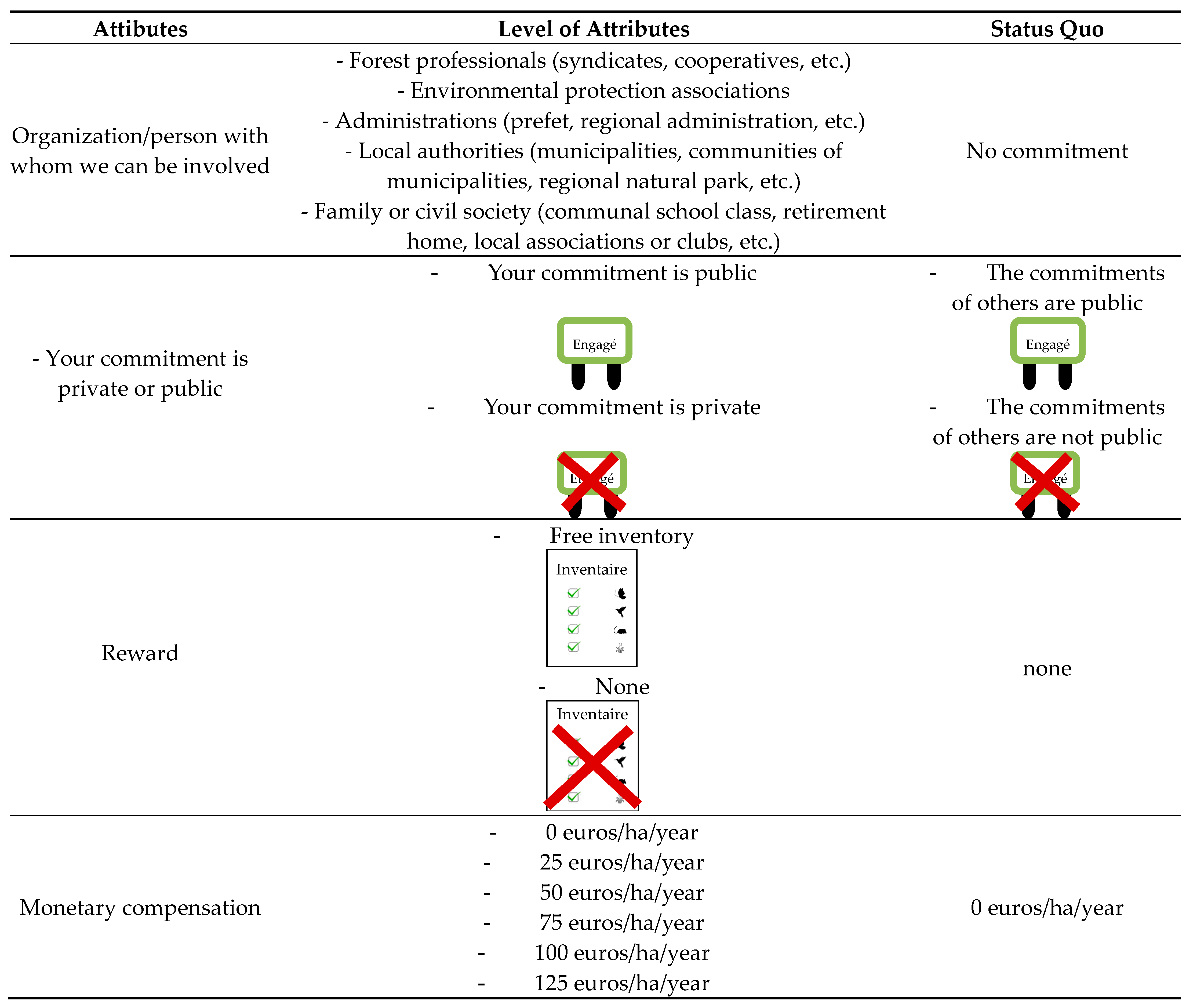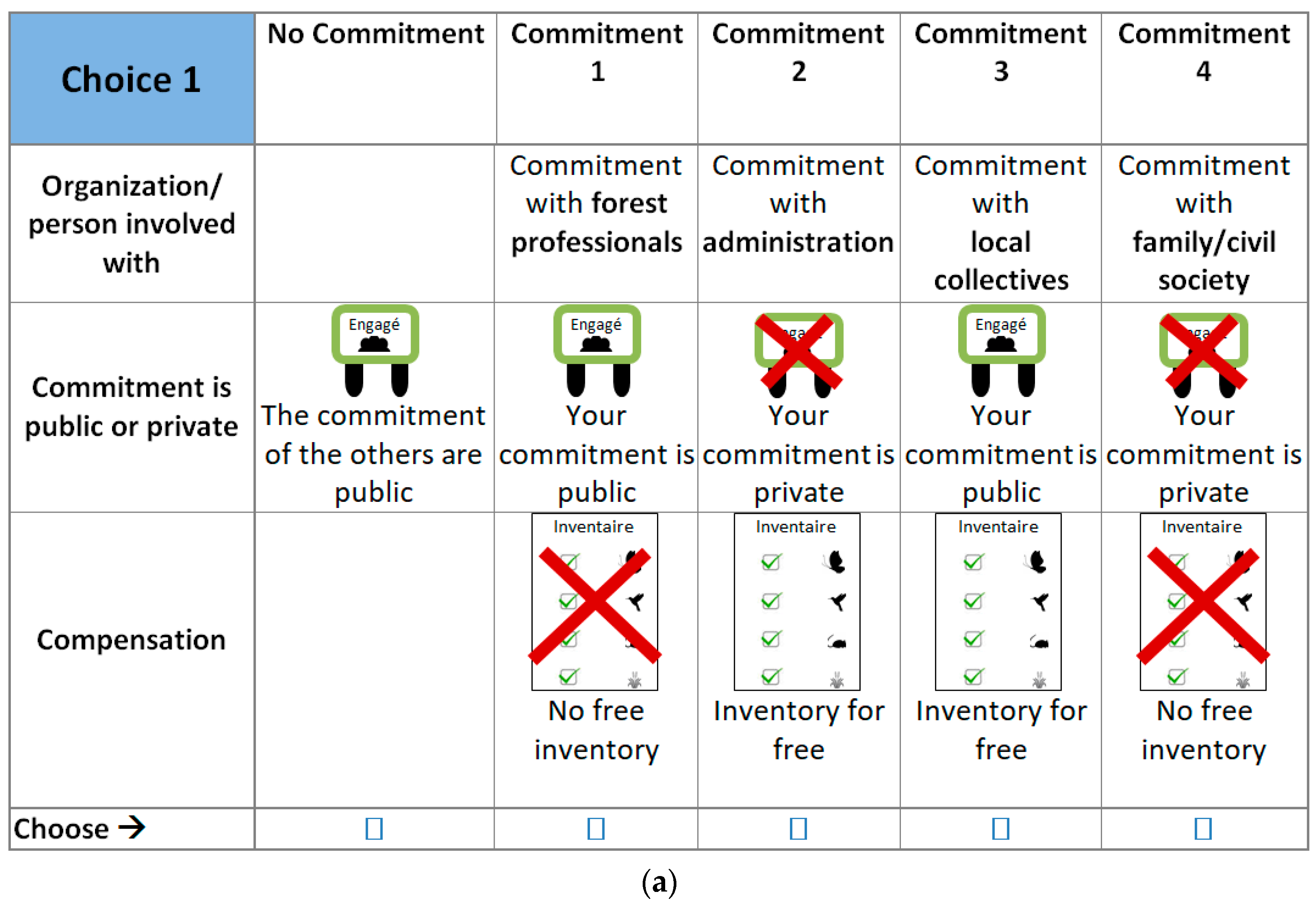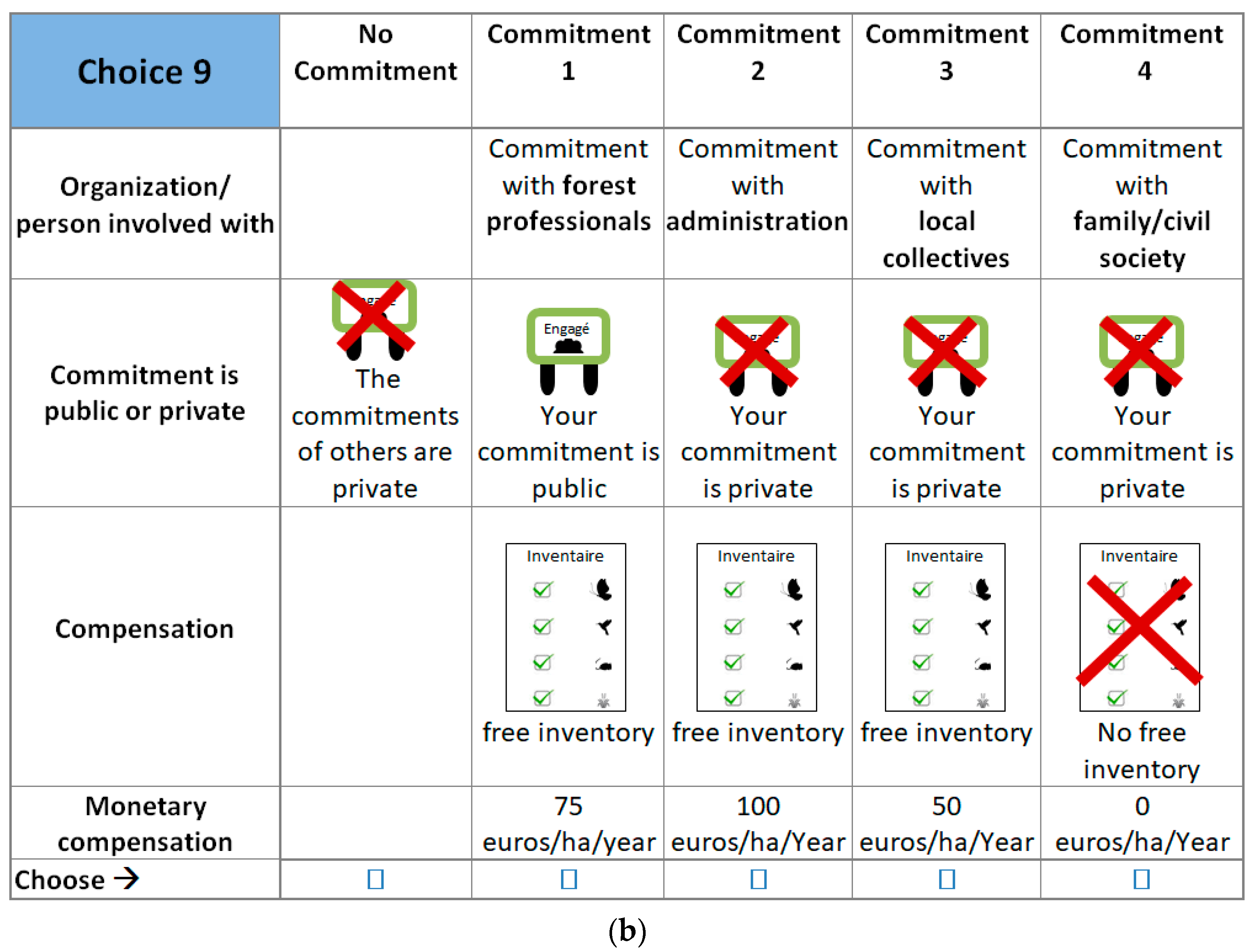2.2. The Discrete Choice Experiment
A discrete choice experiment was used to reveal forest owners’ preferences for an alternative commitment to nature protection. The first step in designing a DCE is to define the alternatives and the attributes. It is important that the selected attributes for the commitment alternatives allow the relevant assumptions to be tested, and that the attributes are relevant to the forest owners’ choices. An important contribution to the definition of attributes comes from the analysis of our collaborative workshop (World Café) that was held with the stakeholders. In
Figure 1 below, we report the selected attributes and their definition.
Since the main objective of this study was to identify the institutional factors that influence commitment, it was decided not to let protection action as such be an attribute. The objective was not to estimate the opportunity costs of forest owners to implement different protection measures but, instead, to estimate how an institutional factor would influence the probability of commitment and how these factors can influence the demand for monetary compensation. However, in order to assess the impact of institutional factors on the decision to initiate it, it was necessary to define relevant and applicable protective measures for all forest owners, from the smallest plot to the largest. In addition, these protective measures should be easy to explain in a questionnaire. Furthermore, by proposing two protection measures and leaving the choice to the owner, we reduce the risk that a forest owner will not accept any commitment and therefore not provide any information on institutional preferences.
It was decided to propose two protection actions:
Leave more dead wood on the ground or standing (diameter >30 cm) than you do today during a harvest (minimum: 5 trees per hectare);
Keep more very large living trees (more than 70 cm in diameter) than you do today (minimum: 2 trees per hectare).
Before the experiment, respondents were asked which of these two biodiversity protection actions is most relevant to their forest. The most relevant was therefore used as a protective measure in all subsequent commitment choices. The hypothesis is that the impact of institutional factors does not depend on which of these two measures is chosen by forest owners.
The first attribute is the organization in which the forest owner is involved (see
Table 1). Four alternatives were chosen, mainly based on the inspiration of our World Café. The second attribute indicates whether the commitment is public or private. If a commitment is public, it will, e.g., be published on the website of the Ballon des Vosges Regional Nature Park and/or on a panel installed at the entrance to the forest, explaining the commitment made. If the commitment is not public, it remains anonymous to the general public and only the organization in which the owner is involved is aware. The third attribute indicates whether the commitment provides access to a non-monetary incentive defined as a reward through a free biodiversity inventory or a calculation of the biodiversity index (PBI) of their plot. Finally, monetary compensation has been included. This is defined as an annual compensation paid per hectare by the government (0–125 euros). However, a monetary incentive was not included if the commitment was with the family or civil society because it was not considered credible.
The second step of our choice experiment consists in defining combinations of alternative commitments and their combination in choice situations. We decided to let each respondent participate in two DCEs. The first DCE did not include the monetary incentive attribute (see
Figure 2a), while the second DCE included monetary and non-monetary incentives (
Figure 2b).
If the respondent knows that a commitment could potentially have monetary compensation, he or she will be less reluctant to accept a commitment without monetary compensation. To test this hypothesis, we let the respondent first choose commitments without mentioning anything about potential monetary compensation. The first part included 12 choice situations and the second part 16 choice situations. A total of 28 choices was considered too numerous for an individual to agree to complete the questionnaire. Two versions of the questionnaire were then developed with six and eight choice situations assigned to each of the two versions, and then randomly distributed to the respondents. The combination of attribute levels is done using a so-called d-efficient model that seeks to maximize the information that can be derived from respondents’ choices and thus reduces the sample size required to estimate the underlying decision model [
32]. A pre-test of the design was carried out on a simulated dataset to verify that it would be possible to test the hypotheses.
The third step consists in formulating an introduction to the choice experiment and follow-up questions. A crucial element of a choice experience is to explain the choice context and the alternatives. The questionnaire included a section presenting the attributes of the commitments. It then explained that the commitment would last at least 20 years, but they could cancel the commitment before if they repaid any reward they may have received. It was also explained that if the property changed ownership, the new owner would be free to choose whether or not to keep the contract. The option to be able to end the contract with ownership change is based on initial discussions that revealed that forest owners were afraid to commit subsequent owners, typically their children. Half of the respondents, selected randomly, were told that they would be the first in their municipality to have one of the proposed commitments, and the other half that they should imagine that half of the forest owners in their municipality have already committed to one of the proposed commitments. Respondents were reminded that they could always choose “no commitment” if they found none of the proposed commitments attractive. Following these responses, there were some follow-up questions where it was asked if the respondent had taken all of the attributes into account when making their choices. Respondents who did not choose a contract in any of the 14 choices were asked why they did not choose a contract in the follow-up questions.
In addition to the choice experiment, the questionnaire included several other questions that facilitated the interpretation of the results of the choice experiment. For example, we asked direct questions about the organization with which they prefer to interact and why. While the choice experiment makes it possible to estimate how forest owners make trade-offs between different attributes (for example, to estimate how the required monetary compensation changes with different organisms), these questions can help explain why forest owners make these trade-offs.
The questionnaire included relatively few questions about the forest and the forest owner since the forest owners interviewed had already participated in a telephone interview and provided this information. The questionnaire was tested within the project group (which included sociologists having carried out qualitative interviews with forest owners) and in face-to-face testing of the questionnaire with forest owners.
The questionnaire was available on the Internet, programmed with LimeSurvey, free software, and hosted by an INRAE server. E-mails were sent to 214 forest owners with two reminders (postal and telephone). E-mail addresses were obtained by a previous telephone interview where the respondents were asked if they would participate in a follow-up survey. Forest owners who did not complete the Internet-based questionnaire were sent a letter with 14 choice cards from the DCE and told that they would be contacted by telephone. Several days after having received this letter, an interviewer from the company Wood!Up contacted the owners and completed the questionnaire with them. When giving the answers to the choice experiment, owners were asked to have the printed choice card in front of them. This approach allowed us to have 99 usable questionnaires. A comparison of the sample obtained with the breakdown of the respondents’ plot size in the telephone survey (
Table 2) shows that the sample obtained is not statistically different (Pearson’s Chi-Square test: X2 = 2.7;
p-value = 0.60).
2.3. The Econometric Analysis
The results from the choice experiment were analyzed using a random utility (profit) model [
33]. Utility of contract
j for forest owner
i is defined in Equation (1): as:
where:
(will be a vector of dummies; one for each commitment considered, whereas no dummy for choosing “no commitment”)
: monetary compensation
: non-monetary compensation
: other contract attributes (institution)
: a random term not observed by the researcher
are the parameters to be estimated, i.e., the marginal impact on utility or profit of the different contract characteristics.
The forest owner will choose the contract j that will give the highest utility:
Test of crowding out: If the parameter of interaction term in (1) is negative, then the utility of money compensation is negative with a published contract (because money paid will show the forest owner as a greedy person). Furthermore, our hypothesis is that non-monetary compensation will not imply crowding out, i.e., .
The sign of the is not clear from theory. People will be more likely to enter into a contract if they think that it will contribute to a positive social image. However, a public contract will reduce the possibility of moral hazard since all visitors to the forest may observe if the owner complies with the contract. By estimating an econometrical model that allows for preference heterogeneity, e.g., a latent class model, we may be able to identify groups of owners that are likely to enter into a contract if they are public, whereas another group is less likely to enter into a contract.
Crowding out associated with owners with prosocial behavior determined by altruistic behavior and who are not influenced by others’ views of them can be identified as a test of linearity of the marginal utility of income (compensation), i.e., a dummy variable which takes the value of one when the payment is zero. If this is positive and significantly different from zero, it can be deduced that there is a disutility of being economically compensated. However, this is a rather weak test as it is based on the assumption that utility is linear as a function of income.










